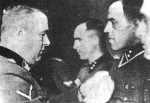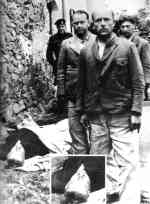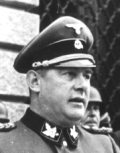 |
| Globocnik |
Odilo Globocnik was born in
Trieste in
1904, to
Austrian – Slovene parents. His father was a Habsburg cavalry lieutenant, later a senior postal official. His mother
was born in Hungary. Globocnik could claim partial Germany ancestry, since both grandmothers bore German names.
The family moved from
Trieste (Italy) to
Klagenfurt (Austria). There is much conflicting evidence
as to when this precisely took place, but according to a
1935 report of the Prefecture of
Trieste, the move occured in
1923.
Globocnik stated on his SS personal file, that he was a master builder,
and had joined the Nazi party in Austria in
1931, party number 442,939. On
1 September 1934 he joined the SS (SS number 292,776).
His illegal pro-Nazi activities in Austria led to several spells in prison; his role in the murder of the
Jewish jeweller
Norbert Futterweit in
June 1933
is open to speculation (
Futterweit was killed in a Nazi bomb attempt in
Wien).
Before the annexation of Austria in
1938, Globocnik was active in the
formation of Nazi cells in the provinces and in
1936 he was appointed provincial
party leader in Kärnten (Carinthia). He played a leading role in the annexation, receiving personal instructions
from
Hitler at the
Reichskanzlei (
Reich's Chancellery) in
Berlin.
On
28 May 1938 Globocnik became
Gauleiter of
Wien. He lost this position in the
end of January 1939,
due to financial irregularities, including accounts set up for the money obtained from Jewish sources, and mis-management
of party funds. Pardoned by
Heinrich Himmler he was appointed
SS- und Polizeiführer für den Distrikt
Lublin on
9 November 1939, and promoted
from
SS-Oberführer to
SS-Brigadeführer und Generalmajor. Globocnik moved into a
villa on
Wieniawska Street in
Lublin and
enjoyed an extravagant lifestyle, as befitting the most powerful man in town. He surrounded himself with a number
of fellow Austrians from Carinthia, to carry out
Himmler's orders regarding
Aktion Reinhard.
Not only did
Aktion Reinhard kill about 1,7-1,8 million Jews, the action also resulted in the plunder of
assets, valuables, and removable property, which all passed through Lublin, amounting to 178 million
Reichsmark.
As well as being responsible for SS and police matters in
Lublin,
Himmler
appointed Globocnik as his "Plenipotentiary for the Construction of SS- and
Police bases in the former Soviet areas" in
July 1941. His base commanders were:
Georg Michalsen (for
Riga),
Kurt Classen
(
Bialystok and
Minsk),
Hermann Höfle
(
Mogilew),
Richard Thomalla
(
Starakonstantinow, Zwiahel and
Kiev).
Hermann Dolp was also prominent in the construction of these bases at
Minsk and
Mogilew. Globocnik and these five
SS officers played a leading part in
Aktion Reinhard one year later.
Globocnik was responsible for
- the final liquidations of the
Warsaw Ghetto and the
Bialystok Ghetto.
- resettling a large number of Poles, particularly around
Zamosc, under the guise of ethnic cleansing. Appointed by
Himmler as head of the SS company
OSTI (Ostindustrie GmbH), he was in
charge of 45,000 Jewish labourers in forced labour camps camps like
Trawniki and
Poniatowa.
- the network of bigger and smaller work camps in the
Lublin district, including the
KZ Majdanek.
 |
Globocnik decorating
Hackenholt |
When the decision about
Aktion Reinhard was taken in
October 1941, Globocnik
spoke out openly that after the "resettlement" of the Jews in the
Generalgouvernement, the Polish population
should be resettled to the East from this region and the
Lublin district should become the first area where this
action would be organised. German colonists (mainly from Bessarabia and Bukowina) would take the place of the Poles.
This conception was part of the larger program to resettle the Slavic nations to the East, behind the Ural mountains
and to prepare this region for German colonisation (
Generalplan Ost). The
Zamosc region was chosen by
Himmler and Globocnik as a laboratory for
the whole
Generalplan Ost. Therefore around 110 villages in the
Zamosc region were resettled
between 1942 and
1943, often combined with mass executions.
Approximately 50,000 Polish peasants were deported to the transit camps in
Zwierzyniec and
Zamosc, later to
Auschwitz,
Majdanek,
and to labour camps in Germany. Thousands escaped to the forests. Many villages were totally destroyed
in the course of this action. The economy of the
Lublin district totally collapsed.
Globocnik’s role as
SSPF Lublin (
SS- und Polizeiführer)
and his central role in the supervision of the death camps of
Aktion Reinhard, in addition to the
Generalplan Ost, created some conflict between him and
Ernst Zörner,
the Civil Gouvernor of the
Lublin district. This conflict arose due to Globocnik’s
ambition to interfere with normal day to day civil matters within the
Lublin area.
Hans Frank, General Gouvernor in Poland, and
Heinrich Himmler were involved in trying to resolve the conflict.
Globocnik's position remained untouched because
Aktion Reinhard had to
be completed.
 |
| Suicide in Paternion |
 |
| Globocnik in Trieste |
Because the Polish underground started to resist Globocnik’s resettlement
plan, the German civil administration in the
Generalgouvernment pressed the SS authorities to stop the action.
Generally the action did not provide the desired result because of large scale resistance, industrial sabotage and
mass escapes of Polish peasants from the villages.
Hans Frank reported his
concerns to
Berlin. As a result
Himmler
issued an order to stop the resettlement action. Globocnik fell out of favour because of the results of his cruel
resettlement policy in the
Zamosc area.
Following the completion of
Aktion Reinhard and the cessation of the
Generalplan Ost,
Globocnik
was ordered to
Trieste (Italy), as
HSSPF Adriatisches Küstenland,
along with the majority of the
Aktion Reinhard
personnel. There he led
Aktion R, the persecution
of partisans and Jews in Istria.
In
October 1944 Globocnik married
Lore Peterschinegg,
head of the Carinthian
BDM (
Bund Deutscher Mädel), this followed a relationship with
Irmgard Rickheim in
Lublin.
Globocnik was arrested by British troops at the
Möslacher Alm, overlooking the
Weissensee Lake in Carinthia / Austria on
31 May 1945.
He committed suicide by poisoning himself at about 11:30 a.m. the same day outside the small prison, 100 m west of the
castle in
Paternion. His body was photographed, together with
Höfle,
Lerch, and
Michalsen.
See Auschwitz Commandant
Höß'
thoughts about Globocnik!
Photos:
USHMM
*
Sources:
Joseph Poprzeczny:
Odilo Globocnik
Siegfried J. Pucher:
"... in der Bewegung führend tätig". Odilo Globocnik - Kämpfer für
den "Anschluß", Vollstrecker des
Holocaust, Klagenfurt 1997
Gerard Reitlinger:
The Final Solution
The Encyclopaedia of the Holocaust
Majdanek 1941-1944. Ed by T. Mencel, Lublin 1991.
© ARC 2005










